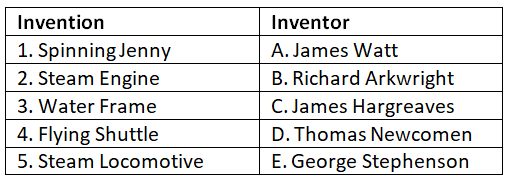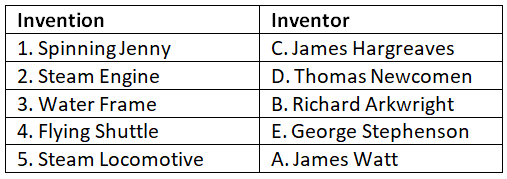Worksheet Solutions: Industrial Revolution | General Knowledge Encyclopedia - Class 8 PDF Download
| Table of contents |

|
| Section A: Multiple Choice Questions (MCQs) |

|
| Section B: Short Questions |

|
| Section C: Fill in the Blanks |

|
| Section D: True or False |

|
| Section E: Match the Column |

|
Section A: Multiple Choice Questions (MCQs)
Q1: When did the Industrial Revolution begin?
(a) 18th century
(b) 15th century
(c) 19th century
(d) 16th century
Ans: (a)
Explanation: The Industrial Revolution is historically recognized to have started in the late 18th century, specifically around the 1760s.
Q2: Which industry marked the starting point of the Industrial Revolution?
(a) Textile
(b) Agriculture
(c) Mining
(d) Transportation
Ans: (a)
Explanation: The Industrial Revolution began with significant advancements in the textile industry, such as the mechanization of weaving and spinning processes.
Q3: What invention made weaving cloth easier during the Industrial Revolution?
(a) Spinning Jenny
(b) Cotton Gin
(c) Flying Shuttle
(d) Steam Engine
Ans: (c)
Explanation: The Flying Shuttle, invented by John Kay in 1733, enabled weavers to work faster, increasing cloth production.
Q4: Why did many people move from rural areas to cities during the Industrial Revolution?
(a) To find better agricultural opportunities
(b) To escape crowded cities
(c) To seek better job prospects in factories
(d) To avoid labor unions
Ans: (c)
Explanation: The growth of factories in urban areas during the Industrial Revolution led to an influx of people from rural regions seeking employment opportunities.
Q5: Which group of workers advocated for better working conditions during the Industrial Revolution?
(a) Factory owners
(b) Industrialists
(c) Labor unions
(d) Farmers' associations
Ans: (c)
Explanation: Labor unions were formed by workers to collectively demand improved wages, working hours, and safer conditions during the Industrial Revolution.
Section B: Short Questions
Q1: Describe the impact of the Industrial Revolution on cities and urban areas.
Ans: The Industrial Revolution led to rapid urbanization, as people moved from rural areas to cities in search of employment opportunities. Cities grew larger but were often crowded, dirty, and unhealthy due to inadequate infrastructure and poor living conditions.
Q2: How did the introduction of machines affect the production and cost of goods during the Industrial Revolution?
Ans: The introduction of machines during the Industrial Revolution increased production efficiency, making it possible to produce goods on a larger scale. This mass production reduced manufacturing costs and led to cheaper prices for goods, benefiting consumers.
Q3: What were some of the challenges faced by factory workers in terms of working conditions and wages?
Ans: Factory workers during the Industrial Revolution faced several challenges, including long working hours (typically 12 to 14 hours a day), low wages, and hazardous working conditions, such as lack of safety regulations and poor ventilation.
Q4: Explain the role of labor unions during the Industrial Revolution and how they contributed to improving workers' rights.
Labor unions played a crucial role in advocating for workers' rights during the Industrial Revolution. They organized strikes, protests, and negotiations with factory owners to secure better working conditions, reasonable wages, and limitations on working hours.
Q5: Discuss two significant inventions that revolutionized the textile industry during the Industrial Revolution.
Ans: Two significant inventions in the textile industry during the Industrial Revolution were the Spinning Jenny, invented by James Hargreaves in 1770, and the Cotton Gin, invented by Eli Whitney in 1793. The Spinning Jenny revolutionized yarn spinning, while the Cotton Gin greatly improved the cleaning of cotton, making cotton production more efficient.
Section C: Fill in the Blanks
Q1: The Industrial Revolution began in ___________ during the late 18th century.
Ans: England
Explanation: The Industrial Revolution is a period of significant industrial and technological advancements that started in England around the late 18th century and later spread to other parts of the world.
Q2: The invention of the ___________ was a crucial development during the Industrial Revolution.
Ans: spinning jenny
Explanation: The spinning jenny, invented by James Hargreaves in 1764, was a key advancement in textile production. It allowed one person to spin multiple threads at the same time, increasing yarn production and boosting the textile industry.
Q3: The shift from hand production to machines led to the growth of ___________ industries.
Ans: industrial
Explanation: Before the Industrial Revolution, most goods were produced by hand in small quantities. The introduction of machines and mechanized production processes during the Industrial Revolution led to the growth of large-scale industrial industries.
Q4: The spinning jenny was invented by ___________.
Ans: James Hargreaves
Explanation: James Hargreaves, a weaver and carpenter from England, invented the spinning jenny in 1764. The machine revolutionized the textile industry by increasing yarn production.
Q5: The Industrial Revolution resulted in a significant rise in ___________.
Ans: urbanization
Explanation: During the Industrial Revolution, there was a mass migration of people from rural areas to cities in search of employment opportunities in factories. This phenomenon is known as urbanization.
Section D: True or False
Q1: The Industrial Revolution mainly occurred in the 16th century.
Ans: False
Explanation: The Industrial Revolution took place during the late 18th century, not the 16th century.
Q2: The use of steam power in factories increased productivity.
Ans: True
Explanation: Steam power was a significant technological advancement during the Industrial Revolution and played a crucial role in increasing the productivity of factories.
Q3: Handicrafts and cottage industries declined during the Industrial Revolution.
Ans: True
Explanation: With the rise of mechanized production in factories, handicrafts and cottage industries faced a decline as mass-produced goods became more prevalent.
Q4: The spinning jenny was used in the cotton industry.
Ans: True
Explanation: Yes, the spinning jenny was primarily used in the cotton industry to spin cotton fibers into yarn.
Q5: The Industrial Revolution only had positive impacts on society.
Ans: False
Explanation: While the Industrial Revolution brought about numerous technological advancements and economic growth, it also had negative impacts, including poor working conditions for laborers and environmental challenges.
Section E: Match the Column

Ans:
|
30 videos|108 docs|27 tests
|




















